TO
Filters: Department: "Kahlert School of Computing" Publication Type: "manuscript" Collection: ir_uspace
| Creator | Title | Description | Subject | Date | ||
|---|---|---|---|---|---|---|
| 1 |
 | Regehr, John | A practical logic framework for verifying safety properties of executables | We present a novel program logic, Lf , which is designed on top of a Hoare logic, but is simpler, more flexible and more scalable. Based on Lf , we develop a framework for automatically verifying safety properties of executables. It utilizes a whole-program interprocedural abstract interpretation to... | 2011-01-01 | |
| 2 |
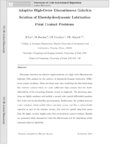 | Berzins, Martin | Adaptive high-order discontinuous galerkin solution of elastohydrodynamic lubrication point contact problems | This paper describes an adaptive implementation of a high order Discontinuous Galerkin (DG) method for the solution of elastohydrodynamic lubrication (EHL) point contact problems. These problems arise when modelling the thin lubricating film between contacts which are under sufficiently high pressur... | 2012-01-01 | |
| 3 |
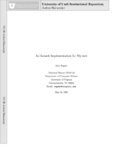 | Regehr, John | An isotach implementation for myrinet | An isotach network provides strong guarantees about message delivery order. We show that an isotach network can be implemented efficiently entirely in software, using commercial o-the-shelf hardware. This report describes that effort. Parts of this implementation could be performed much more efficie... | 1997-01-01 | |
| 4 |
 | Regehr, John | ARMor: fully verified software fault isolation | We have designed and implemented ARMor, a system that uses software fault isolation (SFI) to sandbox application code running on small embedded processors. Sandboxing can be used to protect components such as the RTOS and critical control loops from other, less-trusted components. ARMor guarantees m... | 2011-01-01 | |
| 5 |
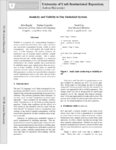 | Regehr, John | Atomicity and visibility in tiny embedded systems | Visibility is a property of a programming language's memory model that determines when values stored by one concurrent computation become visible to other computations. Our work exploits the insight that in nesC, a C-like language with explicit atomicity, the traditional way of ensuring timely visib... | 2006-01-01 | |
| 6 |
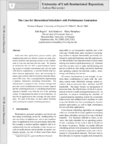 | Regehr, John | The case for hierarchical schedulers with performance guarantees | 2000-01-01 | ||
| 7 |
 | Johnson, Christopher R.; Parker, Steven G.; Whitaker, Ross T.; Hansen, Charles D. | Computational field visualization | Today, scientists, engineers, and medical researchers routinely use computers to simulate complex physical phenomena. Such simulations present new challenges for computational scientists, including the need to effectively analyze and visualize complex three-dimensional data. As simulations become mo... | Volume rendering; Isosurface extraction; Ray tracing; Multi-field visualizations | 2001 |
| 8 |
 | Regehr, John | Deriving abstract transfer functions for analyzing embedded software | This paper addresses the problem of creating abstract transfer functions supporting dataflow analyses. Writing these functions by hand is problematic: transfer functions are difficult to understand, difficult to make precise, and difficult to debug. Bugs in transfer functions are particularly seriou... | 2006-01-01 | |
| 9 |
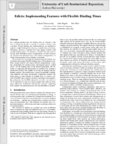 | Regehr, John | Edicts: implementing features with flexible binding times | In a software product line, the binding time of a feature is the time at which one decides to include or exclude a feature from a product. Typical binding site implementations are intended to support a single binding time only, e.g., compile time or run time. Sometimes, however, a product line must... | 2008-01-01 | |
| 10 |
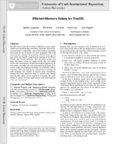 | Regehr, John | Efficient memory safety for TinyOS | Reliable sensor network software is difficult to create: applications are concurrent and distributed, hardware-based memory protection is unavailable, and severe resource constraints necessitate the use of unsafe, low-level languages. Our work improves this situation by providing efficient memory an... | 2007-01-01 | |
| 11 |
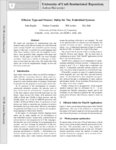 | Regehr, John | Efficient type and memory safety for tiny embedded systems | We report our experience in implementing type and memory safety in an efficient manner for sensor network nodes running TinyOS: tiny embedded systems running legacy, C-like code. A compiler for a safe language must often insert dynamic checks into the programs it produces; these generally make progr... | 2006-01-01 | |
| 12 |
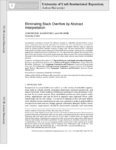 | Regehr, John | Eliminating stack overflow by abstract interpretation | An important correctness criterion for software running on embedded microcontrollers is stack safety: a guarantee that the call stack does not overflow. Our first contribution is a method for statically guaranteeing stack safety of interrupt-driven embedded software using an approach based on contex... | 2005-01-01 | |
| 13 |
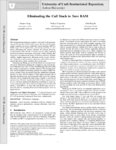 | Regehr, John | Eliminating the call stack to save RAM | Most programming languages support a call stack in the programming model and also in the runtime system.We show that for applications targeting low-power embedded microcontrollers (MCUs), RAM usage can be significantly decreased by partially or completely eliminating the runtime callstack. We presen... | 2009-01-01 | |
| 14 |
 | Riloff, Ellen M. | Empirical study of automated dictionary construction for information extraction in three domains | A primary goal of natural language processing researchers is to develop a knowledge-based natural language processing (NLP) system that is portable across domains. However, most knowledge-based NLP systems rely on a domain-specific dictionary of concepts, which represents a substantial knowledge-en... | Information extraction; AutoSlog; Across domains | 1996 |
| 15 |
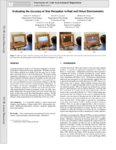 | Thompson, William B. | Evaluating the accuracy of size perception in real and virtual environments | Accurate perception of the size of 3D objects depicted on 2D desktop displays is important for many applications. Whether users perceive objects depicted on a display to be the same size as comparable real world objects is not well understood. We propose using affordances judgments as a way of measu... | 2012-01-01 | |
| 16 |
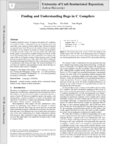 | Regehr, John | Finding and understanding bugs in C compilers | Compilers should be correct. To improve the quality of C compilers, we created Csmith, a randomized test-case generation tool, and spent three years using it to find compiler bugs. During this period we reported more than 325 previously unknown bugs to compiler developers. Every compiler we tested w... | 2011-01-01 | |
| 17 |
 | Regehr, John | Hierarchical schedulers, performance guarantees, and resource management | An attractive approach to scheduling applications with diverse CPU scheduling requirements is to use different schedulers for different applications. For example: real-time schedulers allow applications to perform computations before deadlines, time-sharing schedulers provide high throughput for com... | 1999-01-01 | |
| 18 |
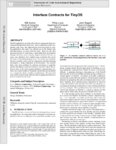 | Regehr, John | Interface contracts for TinyOS | TinyOS applications are built with software components that communicate through narrow interfaces. Since components enable fine-grained code reuse, this approach has been successful in creating applications that make very efficient use of the limited code and data memory on sensor network nodes. How... | 2007-01-01 | |
| 19 |
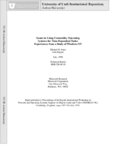 | Regehr, John | Issues in using commodity operating systems for time-dependent tasks: experiences from a study of windows NT | This paper presents a snapshot of early results from a study of Windows NT aimed at understanding and improving its limitations when used for time-dependent tasks, such as those that arise for audio and video processing. Clearly there are time scales for which it can achieve effectively perfect reli... | 1998-01-01 | |
| 20 |
 | Parker, Steven G. | Memory sharing for interactive ray tracing on clusters | We present recent results in the application of distributed shared memory to image parallel ray tracing on clusters. Image parallel rendering is traditionally limited to scenes that are small enough to be replicated in the memory of each node, because any processor may require access to any piece o... | Ray tracing; Out-of-core rendering; Distributed shared memory; Cache miss reduction; Parallel rendering | 2005-02 |
| 21 |
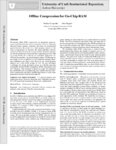 | Regehr, John | Offline compression for on-chip RAM | We present offline RAM compression, an automated source-to-source transformation that reduces a program's data size. Statically allocated scalars, pointers, structures, and arrays are encoded and packed based on the results of a whole-program analysis in the value set and pointer set domains. We tar... | 2007-01-01 | |
| 22 |
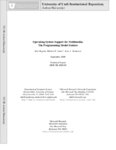 | Regehr, John | Operating system support for multimedia: the programming model matters | Multimedia is an increasingly important part of the mix of applications that users run on personal computers and workstations. The requirements placed on a multimedia operating system are demanding and often conflicting: untrusted, independently written soft real-time applications must be able to co... | 2000-01-01 | |
| 23 |
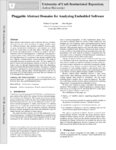 | Regehr, John | Pluggable abstract domains for analyzing embedded software | Many abstract value domains such as intervals, bitwise, constants, and value-sets have been developed to support dataflow analysis. Different domains offer alternative tradeoffs between analysis speed and precision. Furthermore, some domains are a better match for certain kinds of code than others. ... | 2006-01-01 | |
| 24 |
 | Regehr, John | Poster abstract: TinyOS 2.1 adding threads and memory protection to tinyOS | The release of TinyOS 2.0 two years ago was motivated by the need for greater platform flexibility, improved robustness and reliability, and a move towards service oriented application development. Since this time, we have seen the community embrace these efforts and add support for additional hardw... | 2008-01-01 | |
| 25 |
 | Parker, Steven G. | Practical global illumination for interactive particle visualization | Particle-based simulation methods are used to model a wide range of complex phenomena and to solve time-dependent problems of various scales. Effective visualizations of the resulting state will communicate subtle changes in the three-dimensional structure, spatial organization, and qualitative tren... | Interactive particle visualization; Global illumination; Ray tracing; Luminance textures | 2008-02 |
